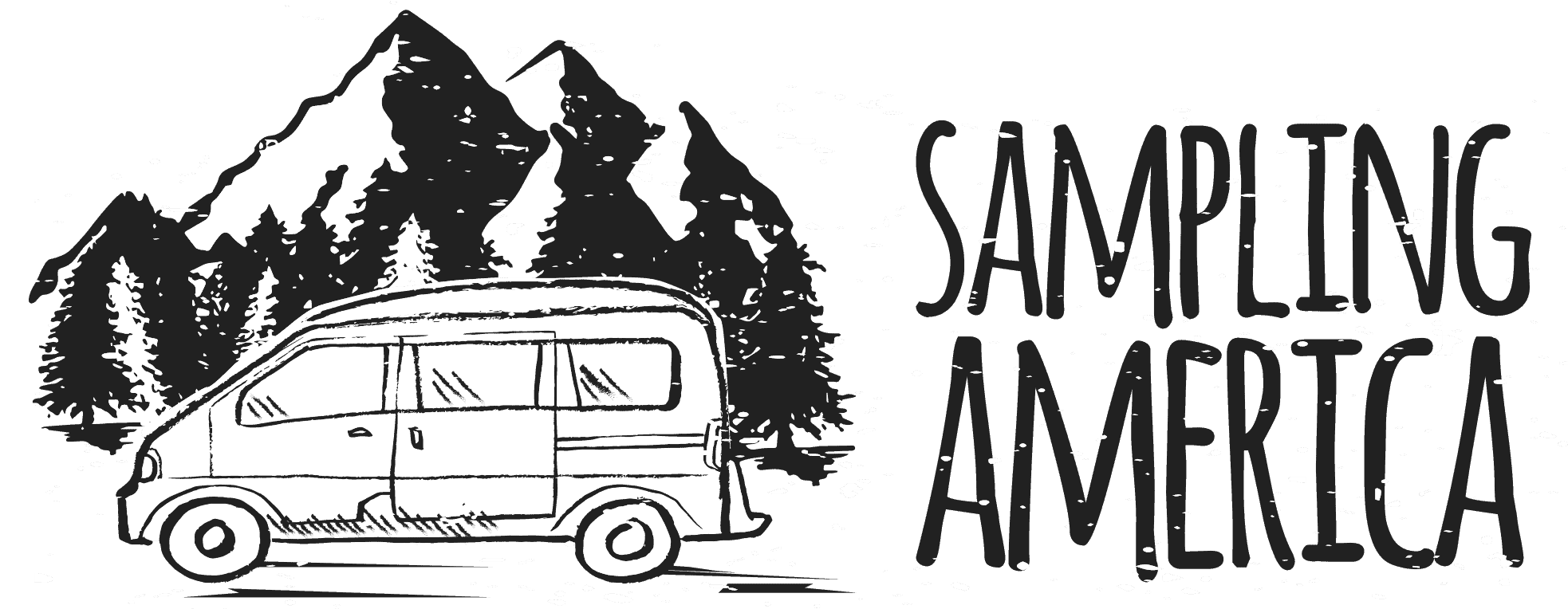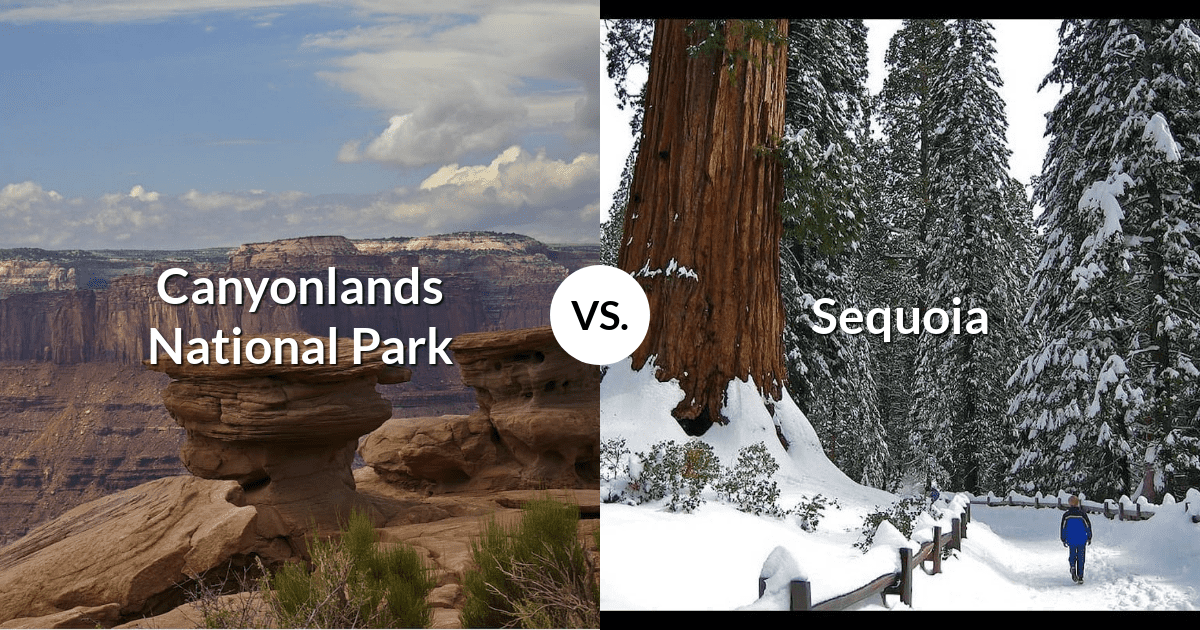Jake Cain is an entrepreneur and writer from Cincinnati, Ohio. He spends his free time driving around the country in his late 90’s conversion van, affectionately known as the “Monster Van” with his wife and 3 boys.
Imagine a world of towering red rock formations and deep canyons, where the only sounds are the whispers of the wind and the distant roar of the Colorado River. This is Canyonlands National Park, a place of raw natural beauty and adventure. Now, imagine towering trees that reach for the sky, some of which are over 2,000 years old. This is Sequoia & Kings Canyon National Parks, a place of awe-inspiring majesty and serenity. Both of these parks offer unique and unforgettable experiences, but which one is right for you? Whether you’re a thrill-seeker looking for a challenge, or a nature lover seeking peace and solitude, these two parks have something for everyone. So, buckle up and get ready to compare Canyonlands and Sequoia & Kings Canyon, two of the most breathtaking national parks in the United States.
Hiking Trails in Canyonlands National Park and Sequoia & Kings Canyon National Parks
Canyonlands National Park and Sequoia & Kings Canyon National Parks both offer a range of hiking trails for visitors to explore.
At Canyonlands, visitors can find trails that range from easy walks along the rim of the canyons to strenuous backpacking trips deep into the park’s wilderness. Some popular trails include the Grand View Point Trail, which offers stunning views of the canyons and mesas, and the Maze Overlook Trail, which takes visitors to a remote corner of the park.
At Sequoia & Kings Canyon, visitors can find trails that range from easy walks through giant sequoia groves to strenuous backpacking trips into the High Sierra. Some popular trails include the General Sherman Tree Trail, which takes visitors to the largest tree in the world, and the Rae Lakes Loop, which offers breathtaking views of the High Sierra.
Whether you’re looking for a leisurely stroll or a challenging backpacking trip, both Canyonlands and Sequoia & Kings Canyon National Parks offer something for everyone. Whether you’re a seasoned hiker or just starting out, these parks are sure to provide you with unforgettable experiences.
Most Popular Hiking Trails in Canyonlands National Park
| Name | Length | Elevation | Type | Difficulty | Visitor Ratings |
|---|---|---|---|---|---|
| Mesa Arch Trail | 965.604 | 18.8976 | Easy | loop | 4.5 |
| Grand View Point Trail | 2896.812 | 52.7304 | Easy | out and back | 4.5 |
| Chesler Park Loop Trail | 18668.344 | 589.788 | Moderate | loop | 5 |
| False Kiva Trail | 3057.746 | 136.8552 | Moderate | out and back | 4.5 |
| Upheaval Dome via Crater View Trail | 2414.01 | 91.7448 | Moderate | out and back | 4 |
| Aztec Butte Trail | 2092.142 | 66.7512 | Moderate | out and back | 4.5 |
| Druid Arch Trail | 15288.73 | 418.7952 | Moderate | out and back | 4.5 |
| Shafer Trail | 30899.328 | 949.7568 | Moderate | point to point | 4.5 |
| White Rim Overlook Trail | 2896.812 | 48.768 | Easy | out and back | 4.5 |
| Syncline Loop | 13840.324 | 496.824 | Very Hard | loop | 4.5 |
Most Popular Hiking Trails in Sequoia & Kings Canyon National Parks
| Name | Length | Elevation | Type | Difficulty | Visitor Ratings |
|---|---|---|---|---|---|
| Moro Rock Trail | 643.736 | 56.9976 | Moderate | out and back | 4.5 |
| Tokopah Falls via Tokopah Valley Trail | 6437.36 | 194.7672 | Moderate | out and back | 4.5 |
| Heather Lake, Emerald Lake, and Pear Lake Trail via Watchtower and Pear Lake Trails | 18990.212 | 887.8824 | Hard | out and back | 5 |
| General Sherman Tree Trail | 1287.472 | 46.9392 | Easy | out and back | 4.5 |
| Marble Falls Trail | 11909.116 | 495.9096 | Moderate | out and back | 4.5 |
| Congress Trail | 5149.888 | 151.7904 | Easy | loop | 4.5 |
| Alta Peak Trail | 23979.166 | 1238.7072 | Very Hard | out and back | 4.5 |
| Mineral King to Eagle Lake Trail | 10460.71 | 674.8272 | Moderate | out and back | 5 |
| Big Trees Trail | 2092.142 | 36.8808 | Easy | loop | 4.5 |
| Giant Forest Loop Trail | 11265.38 | 390.7536 | Easy | loop | 5 |
Wildlife in Canyonlands National Park and Sequoia & Kings Canyon National Parks
Canyonlands National Park and Sequoia & Kings Canyon National Parks are both known for their diverse wildlife and unique ecosystems.
At Canyonlands, visitors can expect to see a variety of wildlife, including desert animals such as bighorn sheep, coyotes, and rattlesnakes. The park is also home to a variety of bird species, including hawks, eagles, and vultures. In addition, the park is home to a variety of cacti and other desert plants, including Joshua trees, creosote bush, and sagebrush.
At Sequoia & Kings Canyon National Parks, visitors can expect to see a variety of wildlife, including black bears, deer, and mountain lions. The parks are also home to a variety of bird species, including peregrine falcons, woodpeckers, and hummingbirds. In addition, the parks are known for their towering sequoia trees, which are some of the largest trees in the world. The parks also feature a variety of other plants, including wildflowers, ferns, and shrubs.
In conclusion, both Canyonlands National Park and Sequoia & Kings Canyon National Parks are known for their diverse wildlife and unique ecosystems, with Canyonlands being known for its desert animals and plants and Sequoia & Kings Canyon being known for its large trees and mountain wildlife.
Below are lists of the most commonly spotted wildlife at Canyonlands National Park and Sequoia & Kings Canyon National Parks. However, you can see a full list of wildlife at each national park here.
Birds
| Canyonlands National Park | Sequoia & Kings Canyon National Parks |
|---|---|
| Peregrine Falcon | Peregrine Falcon |
| Northern Harrier | Northern Harrier |
| Sharp-Shinned Hawk | Sharp-Shinned Hawk |
| Osprey | Osprey |
| Tree Swallow | Tree Swallow |
| Mallard | Mallard |
| Canada Goose | Canada Goose |
| Lincoln’s Sparrow | Lincoln’s Sparrow |
| Ruby-Crowned Kinglet | Ruby-Crowned Kinglet |
| American Robin | American Robin |
| Great Horned Owl | Great Horned Owl |
| Red-Tailed Hawk | Red-Tailed Hawk |
| Northern Flicker | Northern Flicker |
| Merlin | Merlin |
| Barn Swallow | Barn Swallow |
| Savannah Sparrow | Savannah Sparrow |
| Great Blue Heron | Great Blue Heron |
| Hermit Thrush | Hermit Thrush |
| American Kestrel | American Kestrel |
| Bald Eagle | Bald Eagle |
| Song Sparrow | Song Sparrow |
| European Starling | European Starling |
| Northern Pintail | Northern Pintail |
| American Wigeon | Green-Winged Teal |
| Green-Winged Teal | American Pipit |
Mammals
| Canyonlands National Park | Sequoia & Kings Canyon National Parks |
|---|---|
| Coyote | Coyote |
| American Beaver | American Beaver |
| Muskrat | Muskrat |
| Big Brown Bat | Big Brown Bat |
| Bobcat | Bobcat |
| Striped Skunk | Striped Skunk |
| Little Brown Bat | Little Brown Bat |
| Deer Mouse | Deer Mouse |
| Raccoon | Raccoon |
| Black Bear | Black Bear |
| Porcupine | Porcupine |
| Silver-Haired Bat | Silver-Haired Bat |
| Hoary Bat | Hoary Bat |
| Red Fox | Red Fox |
| Long-Tailed Weasel | Long-Tailed Weasel |
| House Mouse | House Mouse |
| Mountain Lion | Mountain Lion |
| American Mink | Mink |
| Mule Deer | Mule Deer |
| Common Gray Fox | Gray Fox |
| Long-Legged Myotis | Wolf |
| Long-Eared Myotis | Long-Legged Myotis |
| American Badger | Long-Eared Myotis |
| Ermine | Badger |
| California Myotis | Ermine |
Fish
| Canyonlands National Park | Sequoia & Kings Canyon National Parks |
|---|---|
| Rainbow Trout | Rainbow Trout |
| Brown Trout | Brook Trout Charr Salter |
| Largemouth Bass | Brown Trout |
| Green Sunfish | Green Sunfish |
| Bluegill | Golden Shiner |
| Fathead Minnow | European Carp |
| Common Carp | Black Bullhead |
| Northern Pike | Brown Bullhead |
| Speckled Dace | Goldfish |
| Yellow Bullhead | Smallmouth Bass |
| Channel Catfish | |
| Kokanee Salmon | |
| Black Crappie | |
| Black Bullhead | |
| Mosquitofish | |
| Smallmouth Bass |
Reptiles
| Canyonlands National Park | Sequoia & Kings Canyon National Parks |
|---|---|
| Gophersnake | Gopher Snake |
| Terrestrial Gartersnake | Western Terrestrial Garter Snake |
| Eastern Racer | Racer |
| Prairie Rattlesnake | Ring-Necked Snake |
| Common Sagebrush Lizard | Sagebrush Lizard |
| Greater Short-Horned Lizard | Common Garter Snake |
| Side-Blotched Lizard | Common Kingsnake |
| Common Kingsnake | Rubber Boa |
| Nightsnake | Nightsnake |
| Long-Nosed Leopard Lizard | Southwestern Black-Headed Snake |
| Striped Whipsnake | Western Whiptail |
| Smith’s Black-Headed Snake | Western Skink |
| Tree Lizard | Long-Nosed Snake |
| Western Whiptail | Western Fence Lizard |
| Eastern Collared Lizard | |
| Desert Spiny Lizard |
Amphibians
| Canyonlands National Park | Sequoia & Kings Canyon National Parks |
|---|---|
| Northern Leopard Frog | Bullfrog |
| Tiger Salamander | |
| American Bullfrog | |
| Woodhouse’s Toad | |
| Red-Spotted Toad | |
| Canyon Treefrog |
Beautiful Landscapes in Canyonlands National Park and Sequoia & Kings Canyon National Parks
Canyonlands National Park is known for its stunning landscape of towering red rock formations and deep canyons, including the Island in the Sky, The Needles, and the Maze. Visitors can see sweeping views of the park from the Island in the Sky mesa, hike to the top of towering rock formations in The Needles, or explore the challenging backcountry of the Maze. Some of the most popular attractions in the park include Mesa Arch, Upheaval Dome, and Grand View Point.
Sequoia & Kings Canyon National Parks are home to some of the largest trees on earth, including the General Sherman Tree, the largest living tree on the planet. The parks are also known for their rugged mountain landscapes, including the Sierra Nevada mountain range and the Kings Canyon, which is one of the deepest canyons in North America. Visitors can hike to stunning overlooks, like Moro Rock and Panoramic Point, and see breathtaking views of the parks. The parks also offer a variety of waterfalls, including Grizzly Falls and Roaring River Falls, as well as the crystal-clear waters of the Kings River.
Both Canyonlands and Sequoia & Kings Canyon offer visitors a chance to experience the beauty and power of nature, from the towering red rock formations of Canyonlands to the towering trees of Sequoia & Kings Canyon. Whether you’re a hiker, photographer, or simply a lover of the great outdoors, these two parks have something for everyone.
Things To-Do and Activities in Canyonlands National Park and Sequoia & Kings Canyon National Parks
Canyonlands National Park and Sequoia & Kings Canyon National Parks both offer a variety of popular activities for visitors to enjoy.
At Canyonlands, popular activities include hiking, backpacking, and scenic drives. The park is known for its rugged terrain and remote location, making it a popular destination for outdoor enthusiasts. Visitors can also participate in ranger-led programs and educational activities, which provide an interactive way to learn about the park’s unique features.
At Sequoia & Kings Canyon National Parks, popular activities include hiking, camping, and scenic drives. The parks are known for their towering sequoia trees, making them a popular destination for nature lovers. Visitors can also take part in ranger-led programs and educational activities, which provide an interactive way to learn about the park’s unique features. In addition, the parks offer a variety of recreational activities, including horseback riding, fishing, and rock climbing.
In conclusion, both Canyonlands National Park and Sequoia & Kings Canyon National Parks offer a variety of popular activities for visitors to enjoy, with Canyonlands being known for its rugged terrain and outdoor activities and Sequoia & Kings Canyon being known for its towering sequoia trees and recreational activities.
Best Time to Visit Canyonlands National Park and Sequoia & Kings Canyon National Parks
Canyonlands National Park and Sequoia & Kings Canyon National Parks both offer unique weather patterns that can greatly affect when is the best time to visit.
Canyonlands is located in southeastern Utah and experiences a desert climate with hot summers and cold winters. Summer temperatures can reach over 100°F, making it a popular time for visitors to explore the park’s canyons and mesas. Winter temperatures can drop below freezing, with snow and ice making some trails and roads impassable.
Sequoia & Kings Canyon is located in California’s Sierra Nevada Mountains and experiences a Mediterranean climate with hot summers and mild winters. Summer temperatures can reach into the 80s, making it a popular time for visitors to explore the park’s giant sequoia groves and high country. Winter temperatures can drop below freezing, with snow and ice making some trails and roads impassable.
In general, the best time to visit Canyonlands is in the spring and fall, when temperatures are mild and the weather is clear. The best time to visit Sequoia & Kings Canyon is in the summer, when the weather is warm and the roads are clear. However, both parks offer unique experiences throughout the year and are worth visiting no matter what the weather may be.
Family Friendliness of Canyonlands National Park and Sequoia & Kings Canyon National Parks
Both Canyonlands National Park and Sequoia & Kings Canyon National Parks are great destinations for families, but each park offers a different experience.
Canyonlands National Park is a great choice for families who enjoy outdoor adventures and exploring natural wonders. The park has several easy to moderate hiking trails, like the Mesa Arch trail, that offer stunning views and can be enjoyed by families with children of all ages. The park also offers ranger-led activities and educational programs, making it a great place for families to learn about the natural world. However, some of the park’s more strenuous trails and backcountry areas may not be suitable for young children.
Sequoia & Kings Canyon National Parks are a great choice for families who enjoy hiking, camping, and exploring the great outdoors. The parks offer a variety of easy to moderate trails, like the Big Trees Trail, that are perfect for families with children of all ages. The parks also offer ranger-led activities, campfire programs, and educational programs, making it a great place for families to learn about the natural world. Additionally, the parks have several family-friendly campgrounds, making it a great destination for families who enjoy camping.
In conclusion, both Canyonlands National Park and Sequoia & Kings Canyon National Parks are great destinations for families, but Sequoia & Kings Canyon may be the better choice for families with young children due to the park’s more family-friendly trails and educational programs. However, both parks offer a unique and unforgettable experience for families, and the best choice will depend on your family’s interests and preferences.


